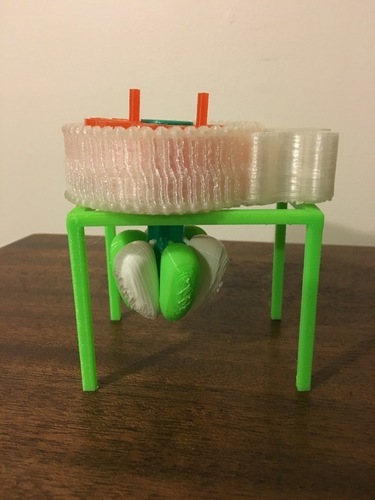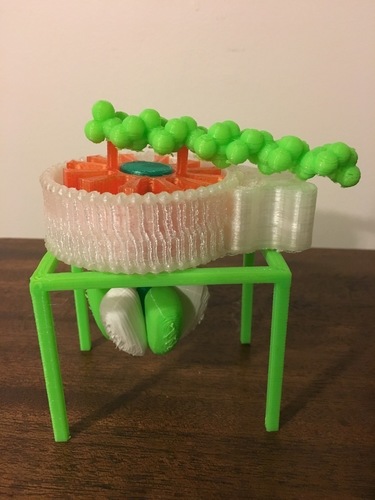

Prints (0)
-
No Prints Yet
Be the first to upload a Print for this Design!
Description
This model of ATP Synthase (ATPase) lets students explore how a proton concentration gradient is used to store energy in the form of ATP. Protons are placed into the protein through the hole on the topside of the membrane. The protons move into the c-subunit. After each proton is added, rotate the c-subunit. Eventually, the proton will drop out the bottom of the membrane. As the c-subunit is spun, the alpha and beta subunits will move, simulating the conformational changes that occur in order for the protein to combine ADP and Pi to form ATP. Also included is an actin filament. A fluorescently labeled actin filament was used in the experiment that first demonstrated the spinning motion of ATP synthase. (It would be really cool to use glow in the dark filament to print this part of the model and then recreate the experiment using a UV light).
Print Settings Printer: Da Vinci Jr. Rafts: No Supports: No Resolution: Does not matter Infill: 5% Notes: The only pieces that require rafts and supports is the actin filament and the hydrogen ions. All other files can be printed without rafts or supports. Post-Printing
Step 1: Insert the outer column into the bottom of the membrane, lining up the tabs.
Step 2: Insert alpha/beta subunits into the slots in the outer column at a 90 degree angle.
Step 3: Once the subunit slides in, rotate to a vertical position.
Step 4: Insert axel into c-subunit. Be sure to line up the bump on the axel with the outline in the top of the subunit.
Step 5: Insert axel into the outer column. Be sure that the bump on the axel lines up with the outline on the column.
Step 6: Place model on frame. Optional: attach actin filament by inserting the columns on the c-subunit into the holes on the filament.
Standards
NGSS
CCSS
Overview and Background Understanding the function of proteins is an important part of a biology course. Specifically, students need to understand the relationship between structure and function of biological molecules. This model of ATP synthase allows students to see how the structure of ATP synthase allows it to produce ATP molecules in the electron transport chain. The model should be used after students have been taught about the structures of proteins. Students should also be familiar with the process of cellular respiration, specifically the electron transport chain in the mitochondria, ions, concentration, and diffusion. Lesson Plan and Activity Before using the model, be sure students understand how energy is stored in a concentration gradient and how a hydrogen ion concentration is built up in the mitochondria. Describe how the small balls represent protons and ask students what will happen if most of the protons are located on the upper side of the membrane. Students can use the model to explore where these ions can go and how the c-subunit can spin in order to move the protons through the membrane. Students should notice how the spinning of the c-subunit causes the lower section of the protein to move. Describe how the energy of this movement is used to combine ADP and Pi to form ATP. The discovery of the way ATPase moves can be re-enacted by using the fluorescent actin filament. Student can either be asked to design an experiment or led through how the experiment was done. The fluorescent filament was attached to the protein and its position measured over time. A fluorescent tag was added so that the scientists could measure the position with a camera (use glow in the dark filament for the actin filament and a UV light if possible) Materials Needed No other materials besides the model are needed.
Objectives Students will be able to describe how the energy in a concentration gradient is transferred into the molecule ATP. Students will be able to label and describe the functions of the different subunits of the ATP synthase protein. Students will be able to describe the process by which the body creates ATP. Students will be able to describe the experiment and data used to show that ATP is a spinning protein and works much like a hydroelectric generator. Students will be able to describe the technique of fluorescence. Results Students should be able to describe the process by which the energy in a concentration gradient is converted into the chemical energy of ATP. The model will serve as a launch point for further discussion into the subunits and structure of this and other proteins. Students can research the mechanisms by which ATP is formed on the chemical level as well as the effects of toxins, drugs, and diseases on these proteins.
Comments